Imagine if our Presidential candidates actually went toe-to-toe on the issues, in a match free of the influence of moderators.
___
One form of public speaking with which we’re all currently familiar is the televised political “debates” in which a number of Presidential candidates stand before an audience and answer questions asked by one or more moderators, with occasional opportunities to comment on what each other has said. Of course this is not really a debate; it’s a group news conference with all the power in the hands of the moderators.
A traditional debate—the sort in which some of us participated in high school or college—is “a formal contest in which the affirmative and negative sides of a proposition are advocated by opposing speakers.” (The Random House Dictionary of the English Language, Unabridged). The topic is set ahead of time, e.g., “Resolved: The Border between the United States and Mexico Should be Closed to All Illegal Immigrants.” The Affirmative speaker would have 10 minutes to make the constructive case for the resolution, followed by the Negative speaker who would have five minutes for cross-examination. Then the Negative speaker would have 10 minutes to make his constructive case, followed by the Affirmative speaker with five minutes for cross-examination. Finally, each would have eight minutes for Rebuttal, beginning with the Affirmative.
This format has several advantages over the pseudo-debates we have now:
- There would be no moderator. The two candidates would be on their own to conduct themselves within the rules of debate, just as they would be on their own if elected President.
- With only two candidates, there would be no logistical problems placing people on the stage, and no cause for complaint that some candidate received more attention than another.
- The focus would be entirely on a single issue, with no references to the candidates’ histories or personalities.
- The format would work for two Presidential candidates from different parties. Imagine a Republican and a Democrat actually debating a foreign policy issue. The novelty of that alone would generate huge publicity.
- The debate would last only 46 minutes; yet each candidate would have 23 minutes to reveal how much he or she knows about a vital topic. You can’t fill that much time with sound bites. The format ensures that the level of each candidate’s knowledge is going to be revealed—like it or not.
- As a result, by the end the audience would have a much better understanding of the candidates’ qualifications on the proposition debated than they do with the arrangement we now have.
Would any candidates step up and agree to this format? I believe some would. Although the candidates at the very top of the polls would probably reject the idea, because they would have something to lose, those candidates in the second tier of popularity should recognize that a good performance in a real mano-a-mano debate could propel them closer to the top. It worked pretty well for Lincoln and Douglas.
Photo—Claudio Gennari/Flickr


Good thought, Brooks, though I’m not sure it’s feasible with a field or more than two and so many pressing issues. Plus, we live in an age of sound bites.
However, having said that, it would be good to have something more substantial than snide questions and moderators who fish for “gotcha” moments. These are big turn-offs and do not educate the public. They make the debates more of an entertainment arena than a forum for serious discussion, and don’t bring out the best in anybody — including, I suspect, the audience.
At any rate, if you’re at all suggesting that the first two debates could have focused on more serious issues and provided more time for candidate explication and interchange, you’re right. At least last night, we got most candidates giving us a sense of what they thought — some substantive information about where they stand and what they would do to address some serious problems. Not detailed pictures, but a step in the right direction, and none of the moderators, thankfully, was disrespectful or obnoxious.